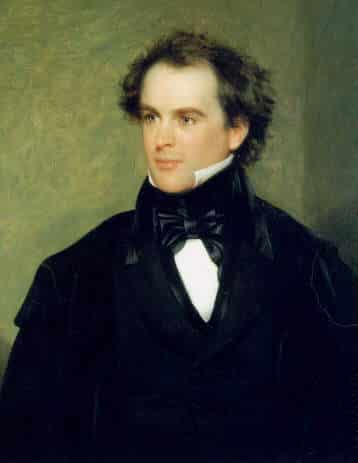Like many writers of his time, Hawthorne emphasized man’s inner reality, and those thoughts and feelings which are not immediately apparent. As he explored this internal nature, he not only found the source of dignity and virtue, but also certain elements of darkness and violence.
In The Minister’s Black Veil, these elements are treated as real and inescapable forces in human existence. The unifying theme is the conflict between the dark, hidden side of man and the standards imposed by his puritanical heritage, and the psychological and practical implications of this conflict.
Hawthorne brings evil and unauthorized desire into the circuit of puritan life and thereby conveys a profound truth that is disturbing in its implication, namely that we can never hope to know each other’s true selves. The themes in the story are suggested by the veil-symbol, the tension between the minister and the community, and the use of pro-Freudian psychological analysis.
The symbolic significance of the black veil lies in the physical and mental barrier that it creates between the minister and his environment, and the guilt that it expresses. Many people believe that the face provides information about a person’s underlying characteristics and, therefore, about his or her probable behavior.
Thus, by wearing the veil, the minister takes away the basis on which people can predict his behavior. This is the main cause of the minister’s isolation, although he is made unpredictable already by the mere act of wearing the veil. Part of the frightening effect of the veil derives from the knowledge that the person behind it can see everything without being seen himself:
“Each member of the congregation, the most innocent girl, and the man of hardened breast felt as if the preacher had crept upon them, behind this awful veil, and discovered their hoarded iniquity of deed or thought.”
Because the members of the congregation cannot see where their minister is looking, they imagine that they are being observed more closely than usual. This notion is strengthened by the subject of the sermon, which “had reference to secret sin, and those sad mysteries which we hide from our nearest and dearest”.
Thus, the minister takes on the role of “the Omniscient” (God), whose investigating glance can penetrate even the deepest mysteries of the human soul. More importantly, the wearing of the veil is a confession of guilt. Being a traditional example for the community, the minister thus implies that everyone should do the same. Important themes in relation to this are the problem of sin, and guilt which is admitted openly vs. guilt which is hidden.
The alienation of the minister is emphasized through the use of explicit and implicit tensions involving the minister and his environment. Before the entering of the minister, the environment is described using adjectives like “bright” and “pretty”. After the minister appears in his veil, typical adjectives include “darkened”, “gloomy”, and “quiet”. This contrast reflects one of the most important themes in the story, namely light vs. dark. Although the word “light” implies positive themes, it is important to note that Hawthorne is not praising the puritan lifestyle.
On the contrary, he is criticizing a society that can be so intolerant of individuals who have slipped from the path of virtue and seem deeply concerned with the increasing discipline exercised over selves in order to live up to the collective identity of puritan America. This is evident in the more implicit conflict between the individual and society, which includes themes such as integrity vs. hypocrisy and free will vs. conformity.
The general conflict between puritanism and instinct reinforces the notion that humans are dualistic, with an innate, dark side and an internalized, moralistic side. For those familiar with the personality theory of Freud, this interpretation of the tale will sound tired, although it is probably the one that best matches Hawthorne’s point of view.
According to this line of thought, the “darkness” that Hawthorne describes is a natural part of the personality. However, because of social pressures, it rarely enters awareness other than in some misinterpreted form. When the minister acknowledges the darkness in himself, he breaks the barrier that protects his conscious self from his unacceptable, repressed self. This barrier is incarnated in the veil, which is then transferred expression of hidden sin.
The parishioners represent the conscious part of the personality, which includes the morals and values dictated by society. To avoid threatening perceptions from entering consciousness, they use different defense mechanisms. The diversity of these defense mechanisms is demonstrated by the reactions to the minister’s sermon (page 3). Some people look for means of evaluating the situation, such as the presence of others. Others attempt to distract themselves from their thoughts, by talking and laughing loudly. The third group of people denies or distort their experiencing of the situation.
Although written 160 years ago, The Minister’s Black Veil is still relevant in both theme and attitude. The black veil is a symbol, something that Hawthorne uses to stand for the impassable barrier between all human souls. What he is trying to say is that each of us wears his own “black veil”. Nevertheless, if we are willing to acknowledge the darkness in ourselves, there is an hour to come…when all of us shall cast aside our veils.


so good, but better is to give separate names of the themes for better understanding.